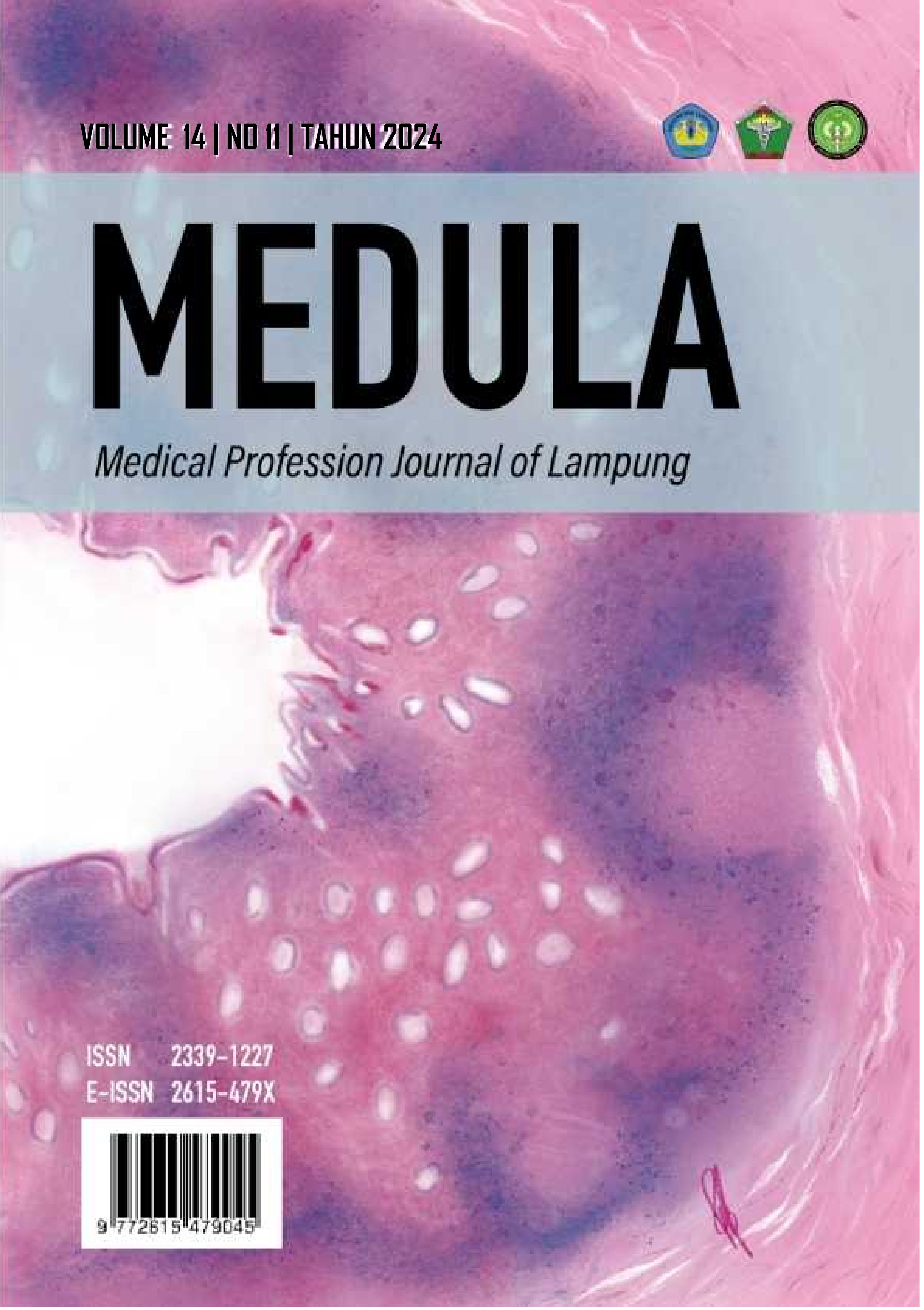Personal and Environmental Risk Factors in The Incidence of Typhoid Fever
DOI:
https://doi.org/10.53089/medula.v14i11.1328Abstract
Typhoid fever is one of the infectious diseases that has a fairly high morbidity and mortality rate, especially in developing countries, especially in Indonesia. Typhoid fever is an infectious disease caused by the bacteria Salmonella typhi. This disease can be transmitted through consuming water or food contaminated with urine and feces from typhoid fever sufferers, for example, water that will be used for drinking, cooking, or washing food ingredients. There are more serious clinical symptoms, such as high fever or hyperthermia, remittent fever, and decreased level of consciousness that can lead to coma or delirium. Further complications such as dehydration and acidosis can also occur, which have negative impacts in cases of typhoid fever. The purpose of this review article is to determine what personal and environmental risk factors are present in the occurrence of typhoid fever. The method used in this study is a review article with specific research of various articles found, then combined and a summary conclusion is drawn. The journals used have been published for the past 5 years (2019-2024). The results and conclusions show that several personal and environmental risk factors in the occurrence of typhoid fever include age, gender, personal hygiene, and clean water sources.
References
WHO. Basic Documents: 49th edition. World Health Organization 2020. 2020. 1–244 p.
Kemenkes RI. Profil Kesehatan Indonesia. Kementerian Kesehatan Republik Indonesia, Jakarta. 2017. 7–32 p.
Dinas Kesehatan Provinsi Lampung. Buku Saku Kesehatan Provinsi Lampung Tahun 2018. Dinkes Lampung. 2018;(44):150.
Sjahrian T. Faktor-Faktor Yang Berhubungan Dengan Kejadian Demam Tifoid Pada Anak. J Med Malahayati. 2019;2(1):1–7.
Masyrofah D, Hilmi IL, Salman S. Review Artikel : Hubungan Umur dengan Demam Tifoid. J Pharm Sci. 2023;6(1):215–20.
Rosa Nian Shakila RRR. a Faktor Risiko Yang Memengaruhi Kejadian Demam Tifoid Di Wilayah Kerja Puskesmas Binakal Kabupaten Bondowoso. Med Technol Public Heal J. 2020;4(2):224–37.
Ladyani MF, Rakhmi R, Bonita M. Hubungan Faktor Determinan Dengan Kejadian Demam Tifoid Pada Pasien Rawat Inapdi Rumah Sakit Pertamina Bintang Amin Tahun 2018. J Med Malahayati. 2020;4(4):274–82.
Fachrizal Y, Handayani Y, Ashan H. Faktor-Faktor yang Berhubungan Dengan Kejadian Demam Tifoid pada Anak di Rumah Sakit Stroke Nasional Bukittinggi Tahun 2019. SCIENA. 2022; I (3).
Manalu TN, Rantung J. Faktor-Faktor yang Mempengaruhi Kejadian Demam Tifoid. J Penelit Perawat Prof. 2021;3:653–60.
Kaunang julia pingkan wulan. Demam Tifoid (Epidemiologi Penyakit Menular). 2022.
Annisa F, Rahmadani A. Faktor – Faktor Yang Berhubungan Dengan Demam Tifoid Pada Anak Di Beberapa Lokasi Di Wilayah Indonesia Periode Tahun 2013 Sampai Dengan Tahun 2020. J Ilm Ecosyst. 2022;22(2):372–82.
Rahmayani, Rosita S, Za RN, Salamah U. Faktor-Faktor yang Mempengaruhi Kejadian Demam Tifoid di Wilayah Kerja Puskesmas Rikit Gaib Kabupaten Gayo Lues Factors influencing the incidence of typhoid fever in the working area of Rikit Ghaib Community Health Center , Gayo Lues Regency. J Healthc Technol Med. 2023;9(2):1627–35.
Betan A, Badaruddin B, Fatmawati F. Personal Hygiene dengan Kejadian Demam Tifoid. J Ilm Kesehat Sandi Husada. 2022;11:505–12.
Safira S, Nurmaini, Dharma S. Hubungan Kepadatan Lalat Personal Hygiene Dan Sanitasi Dasar Dengan Kejadian Diare. Lingkung dan Keselam Kerja. 2015;4(3):1–10.
Darmawan D. profil kesehatan Indonesia 2019. Journal of Chemical Information and Modeling. 2019.
Marsa A, Elmiyati, Ananda E. Hubungan Personal Hygiene dan Sanitasi Lingkungan Terhadap Prevalensi Terjadinya Demam Tifoid di Rumah Sakit Umum Daerah (RSUD) Meuraxa Kota Banda Aceh Tahun 2018. Ris dan Inov Pendidik. 2020;2(2):24–34.
Azhar K, Dharmayanti I, Anwar A. Pengaruh Akses Air Minum terhadap Kejadian Penyakit Tular Air (Diare dan Demam Tifoid). 2019;17(29):107–14.
Downloads
Published
How to Cite
Issue
Section
License
Copyright (c) 2025 Medical Profession Journal of Lampung

This work is licensed under a Creative Commons Attribution-ShareAlike 4.0 International License.














